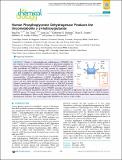Human Phosphoglycerate Dehydrogenase Produces the Oncometabolite d-2-Hydroxyglutarate
Author(s)
Teng, Xin; Liu, Ling; Looper, Ryan E.; Rabinowitz, Joshua D.; Vander Heiden, Matthew G.; Mattaini, Katherine Ruth; Fan, Jing,M. Eng.Massachusetts Institute of Technology.; ... Show more Show less
DownloadHuman Phosphoglycerate Dehydrogenase.pdf (2.046Mb)
PUBLISHER_POLICY
Publisher Policy
Article is made available in accordance with the publisher's policy and may be subject to US copyright law. Please refer to the publisher's site for terms of use.
Terms of use
Metadata
Show full item recordAbstract
Human d-3-phosphoglycerate dehydrogenase (PHGDH), the first enzyme in the serine biosynthetic pathway, is genomically amplified in tumors including breast cancer and melanoma. In PHGDH-amplified cancer cells, knockdown of PHGDH is not fully rescued by exogenous serine, suggesting possible additional growth-promoting roles for the enzyme. Here we show that, in addition to catalyzing oxidation of 3-phosphoglycerate, PHGDH catalyzes NADH-dependent reduction of α-ketoglutarate (AKG) to the oncometabolite d-2-hydroxyglutarate (d-2HG). Knockdown of PHGDH decreased cellular 2HG by approximately 50% in the PHGDH-amplified breast cancer cell lines MDA-MB-468 (normal concentration 93 μM) and BT-20 (normal concentration 35 μM) and overexpression of PHGDH increased cellular 2HG by over 2-fold in non-PHGDH-amplified MDA-MB-231 breast cancer cells, which normally display very low PHGDH expression. The reduced 2HG level in PHGDH knockdown cell lines can be rescued by PHGDH re-expression, but not by a catalytically inactive PHGDH mutant. The initial connection between cancer and d-2HG involved production of high levels of d-2HG by mutant isocitrate dehydrogenase. More recently, however, elevated d-2HG has been observed in breast cancer tumors without isocitrate dehydrogenase mutation. Our results suggest that PHGDH is one source of this d-2HG.
Date issued
2014-11Department
Massachusetts Institute of Technology. Department of Biology; Koch Institute for Integrative Cancer Research at MITJournal
ACS Chemical Biology
Publisher
American Chemical Society (ACS)
Citation
Fan, Jing et al. “Human Phosphoglycerate Dehydrogenase Produces the Oncometabolite d-2-Hydroxyglutarate.” ACS Chemical Biology 10.2 (2015): 510–516. CrossRef. Web. © 2014 American Chemical Society
Version: Final published version
ISSN
1554-8929
1554-8937